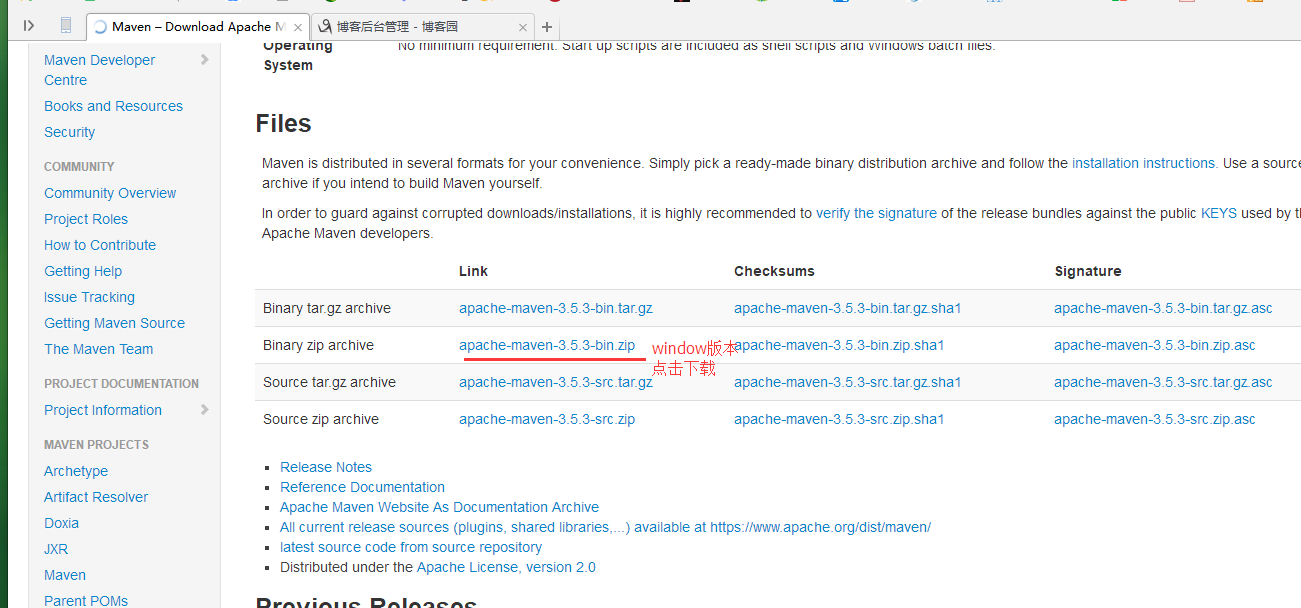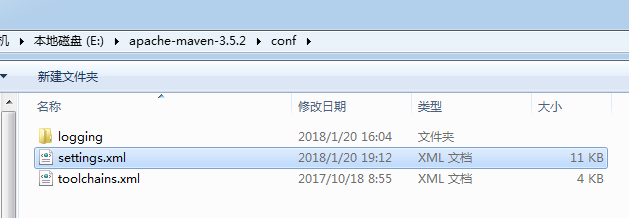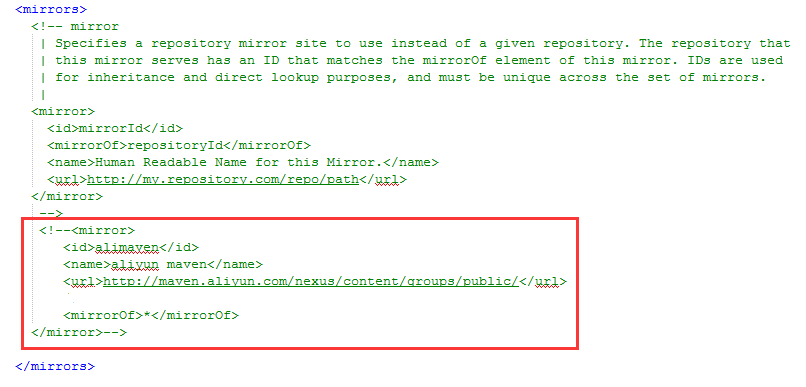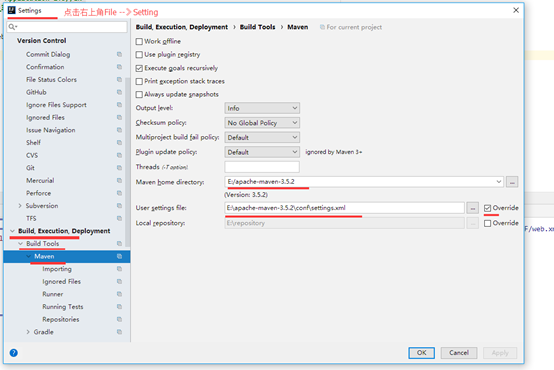Maven下载 || 配置本地仓库 || IntelliJ IDEA配置Maven教程
本文章主要介绍1.Maven下载 2.配置本地仓库Repository 3.IDEA配置Maven 三点。
相关博客:
Eclipse配置Maven https://www.cnblogs.com/hero123/p/9076260.html
ItelliJ IDEA下载及获取注册码详解 https://www.cnblogs.com/hero123/p/9092178.html
IntelliJ IDEA创建Maven+SSM+Tomcat+Git项目【全程详解】https://www.cnblogs.com/hero123/p/9092576.html
首先下载Maven :
Maven官网下载地址:http://maven.apache.org/download.cgi ,下载后解压:

其次配置Maven中的setting 文件:
1/找到刚才解压Maven文件,然后找到/conf/settings.xml

2/修改配置文件中的本地仓库路径,和远程仓库路径(我配置的是阿里镜像仓库,jar包下载速度快)
<?xml version="1.0" encoding="UTF-8"?> <!--
Licensed to the Apache Software Foundation (ASF) under one
or more contributor license agreements. See the NOTICE file
distributed with this work for additional information
regarding copyright ownership. The ASF licenses this file
to you under the Apache License, Version 2.0 (the
"License"); you may not use this file except in compliance
with the License. You may obtain a copy of the License at http://www.apache.org/licenses/LICENSE-2.0 Unless required by applicable law or agreed to in writing,
software distributed under the License is distributed on an
"AS IS" BASIS, WITHOUT WARRANTIES OR CONDITIONS OF ANY
KIND, either express or implied. See the License for the
specific language governing permissions and limitations
under the License.
--> <!--
| This is the configuration file for Maven. It can be specified at two levels:
|
| 1. User Level. This settings.xml file provides configuration for a single user,
| and is normally provided in ${user.home}/.m2/settings.xml.
|
| NOTE: This location can be overridden with the CLI option:
|
| -s /path/to/user/settings.xml
|
| 2. Global Level. This settings.xml file provides configuration for all Maven
| users on a machine (assuming they're all using the same Maven
| installation). It's normally provided in
| ${maven.conf}/settings.xml.
|
| NOTE: This location can be overridden with the CLI option:
|
| -gs /path/to/global/settings.xml
|
| The sections in this sample file are intended to give you a running start at
| getting the most out of your Maven installation. Where appropriate, the default
| values (values used when the setting is not specified) are provided.
|
|-->
<settings xmlns="http://maven.apache.org/SETTINGS/1.0.0"
xmlns:xsi="http://www.w3.org/2001/XMLSchema-instance"
xsi:schemaLocation="http://maven.apache.org/SETTINGS/1.0.0 http://maven.apache.org/xsd/settings-1.0.0.xsd">
<!-- localRepository
| The path to the local repository maven will use to store artifacts.
|
| Default: ${user.home}/.m2/repository -->
<localRepository>E:/repository</localRepository> <!-- interactiveMode
| This will determine whether maven prompts you when it needs input. If set to false,
| maven will use a sensible default value, perhaps based on some other setting, for
| the parameter in question.
|
| Default: true
<interactiveMode>true</interactiveMode>
--> <!-- offline
| Determines whether maven should attempt to connect to the network when executing a build.
| This will have an effect on artifact downloads, artifact deployment, and others.
|
| Default: false
<offline>false</offline>
--> <!-- pluginGroups
| This is a list of additional group identifiers that will be searched when resolving plugins by their prefix, i.e.
| when invoking a command line like "mvn prefix:goal". Maven will automatically add the group identifiers
| "org.apache.maven.plugins" and "org.codehaus.mojo" if these are not already contained in the list.
|-->
<pluginGroups>
<!-- pluginGroup
| Specifies a further group identifier to use for plugin lookup.
<pluginGroup>com.your.plugins</pluginGroup>
-->
</pluginGroups> <!-- proxies
| This is a list of proxies which can be used on this machine to connect to the network.
| Unless otherwise specified (by system property or command-line switch), the first proxy
| specification in this list marked as active will be used.
|-->
<proxies>
<!-- proxy
| Specification for one proxy, to be used in connecting to the network.
|
<proxy>
<id>optional</id>
<active>true</active>
<protocol>http</protocol>
<username>proxyuser</username>
<password>proxypass</password>
<host>proxy.host.net</host>
<port>80</port>
<nonProxyHosts>local.net|some.host.com</nonProxyHosts>
</proxy>
-->
</proxies> <!-- servers
| This is a list of authentication profiles, keyed by the server-id used within the system.
| Authentication profiles can be used whenever maven must make a connection to a remote server.
|-->
<servers>
<!-- server
| Specifies the authentication information to use when connecting to a particular server, identified by
| a unique name within the system (referred to by the 'id' attribute below).
|
| NOTE: You should either specify username/password OR privateKey/passphrase, since these pairings are
| used together.
|
<server>
<id>deploymentRepo</id>
<username>repouser</username>
<password>repopwd</password>
</server>
--> <!-- Another sample, using keys to authenticate.
<server>
<id>siteServer</id>
<privateKey>/path/to/private/key</privateKey>
<passphrase>optional; leave empty if not used.</passphrase>
</server>
-->
</servers> <!-- mirrors
| This is a list of mirrors to be used in downloading artifacts from remote repositories.
|
| It works like this: a POM may declare a repository to use in resolving certain artifacts.
| However, this repository may have problems with heavy traffic at times, so people have mirrored
| it to several places.
|
| That repository definition will have a unique id, so we can create a mirror reference for that
| repository, to be used as an alternate download site. The mirror site will be the preferred
| server for that repository.
|-->
<mirrors>
<!-- mirror
| Specifies a repository mirror site to use instead of a given repository. The repository that
| this mirror serves has an ID that matches the mirrorOf element of this mirror. IDs are used
| for inheritance and direct lookup purposes, and must be unique across the set of mirrors.
|
<mirror>
<id>mirrorId</id>
<mirrorOf>repositoryId</mirrorOf>
<name>Human Readable Name for this Mirror.</name>
<url>http://my.repository.com/repo/path</url>
</mirror>
-->
<!--<mirror>
<id>alimaven</id>
<name>aliyun maven</name>
<url>http://maven.aliyun.com/nexus/content/groups/public/</url>
//<mirrorOf>central</mirrorOf>
<mirrorOf>*</mirrorOf>
</mirror>--> </mirrors> <!-- profiles
| This is a list of profiles which can be activated in a variety of ways, and which can modify
| the build process. Profiles provided in the settings.xml are intended to provide local machine-
| specific paths and repository locations which allow the build to work in the local environment.
|
| For example, if you have an integration testing plugin - like cactus - that needs to know where
| your Tomcat instance is installed, you can provide a variable here such that the variable is
| dereferenced during the build process to configure the cactus plugin.
|
| As noted above, profiles can be activated in a variety of ways. One way - the activeProfiles
| section of this document (settings.xml) - will be discussed later. Another way essentially
| relies on the detection of a system property, either matching a particular value for the property,
| or merely testing its existence. Profiles can also be activated by JDK version prefix, where a
| value of '1.4' might activate a profile when the build is executed on a JDK version of '1.4.2_07'.
| Finally, the list of active profiles can be specified directly from the command line.
|
| NOTE: For profiles defined in the settings.xml, you are restricted to specifying only artifact
| repositories, plugin repositories, and free-form properties to be used as configuration
| variables for plugins in the POM.
|
|-->
<profiles>
<!--
<id>jdk17</id>
<activation>
<activeByDefault>true</activeByDefault>
<jdk>1.7</jdk>
</activation>
<properties>
<maven.compiler.source>1.7</maven.compiler.source>
<maven.compiler.target>1.7</maven.compiler.target>
<maven.compiler.compilerVersion>1.7</maven.compiler.compilerVersion>
</properties> -->
<!-- profile
| Specifies a set of introductions to the build process, to be activated using one or more of the
| mechanisms described above. For inheritance purposes, and to activate profiles via <activatedProfiles/>
| or the command line, profiles have to have an ID that is unique.
|
| An encouraged best practice for profile identification is to use a consistent naming convention
| for profiles, such as 'env-dev', 'env-test', 'env-production', 'user-jdcasey', 'user-brett', etc.
| This will make it more intuitive to understand what the set of introduced profiles is attempting
| to accomplish, particularly when you only have a list of profile id's for debug.
|
| This profile example uses the JDK version to trigger activation, and provides a JDK-specific repo.
<profile>
<id>jdk-1.4</id> <activation>
<jdk>1.4</jdk>
</activation> <repositories>
<repository>
<id>jdk14</id>
<name>Repository for JDK 1.4 builds</name>
<url>http://www.myhost.com/maven/jdk14</url>
<layout>default</layout>
<snapshotPolicy>always</snapshotPolicy>
</repository>
</repositories>
</profile>
--> <!--
| Here is another profile, activated by the system property 'target-env' with a value of 'dev',
| which provides a specific path to the Tomcat instance. To use this, your plugin configuration
| might hypothetically look like:
|
| ...
| <plugin>
| <groupId>org.myco.myplugins</groupId>
| <artifactId>myplugin</artifactId>
|
| <configuration>
| <tomcatLocation>${tomcatPath}</tomcatLocation>
| </configuration>
| </plugin>
| ...
|
| NOTE: If you just wanted to inject this configuration whenever someone set 'target-env' to
| anything, you could just leave off the <value/> inside the activation-property.
|
<profile>
<id>env-dev</id> <activation>
<property>
<name>target-env</name>
<value>dev</value>
</property>
</activation> <properties>
<tomcatPath>/path/to/tomcat/instance</tomcatPath>
</properties>
</profile>
-->
</profiles> <!-- activeProfiles
| List of profiles that are active for all builds.
|
<activeProfiles>
<activeProfile>alwaysActiveProfile</activeProfile>
<activeProfile>anotherAlwaysActiveProfile</activeProfile>
</activeProfiles>
-->
</settings>
其中两个位置需要注意:本地仓库路径(你生成自己的仓库地址,注意路径时/ ,不是\ )和阿里云maven镜像配置(此处我注了,你可以放开)


然后在IDEA中配置Maven:
打开IDEA,点击右上角File --> Setting .

配置好后,点击Apply,--> OK 应用即可。
Maven下载 || 配置本地仓库 || IntelliJ IDEA配置Maven教程的更多相关文章
- Maven配置,使用IntelliJ IDEA和Maven创建Java Web项目
1. 下载Maven 官方地址:http://maven.apache.org/download.cgi 解压并新建一个本地仓库文件夹 2.配置本地仓库路径 3.配置maven环境变量 4 ...
- maven的下载安装,配置本地仓库
maven的下载安装 下载地址:http://maven.apache.org/download.cgi 下载完成后解压到某一个目录 配置环境变量 第一个环境变量 MAVEN_HOME A:\mave ...
- 安装时后的idea,项目不能运行,pom.xml文件不能下载到本地仓库,maven配置是正确的
安装时后的idea,项目不能运行,pom.xml文件不能下载到本地仓库,maven配置是正确的 项目上传到svn后,同事下载项目后,没有识别出来mavn中的pom.xml文件,导致idea不能自动下载 ...
- Java开发学习(三十四)----Maven私服(二)本地仓库访问私服配置与私服资源上传下载
一.本地仓库访问私服配置 我们通过IDEA将开发的模块上传到私服,中间是要经过本地Maven的 本地Maven需要知道私服的访问地址以及私服访问的用户名和密码 私服中的仓库很多,Maven最终要把资源 ...
- (一)maven之——maven基础及本地仓库的配置
一.初步了解maven Apache Maven是一个软件项目管理的综合工具.基于项目对象模型(POM)的概念,提供了帮助管理构建.文档.报告.依赖.发布等方法,Maven简化和标准化项目建设过程.处 ...
- myeclipse2014 安装maven3.3.9和maven配置本地仓库 及错误修改
结合网上的知识梳理以及自己安装的经验 myeclipse2014 安装maven3.3.9和maven配置本地仓库 及犯的错误修改 成功搞定maven 1,安装 Maven 之前要求先确定你的 J ...
- maven配置本地仓库、maven配置阿里中央仓库、eclipse配置maven
一.maven配置本地仓库路径 1.打开下载好的maven目录 (若没安装,可以看我写的安装步骤https://www.cnblogs.com/xjd-6/p/11344719.html) 2.进入c ...
- maven的setting.xml文件中只配置本地仓库路径的方法
maven的setting.xml文件中只配置本地仓库路径的方法 即:settings标签下只有一个 localRepository标签,其他全部注释掉即可 <?xml version=&quo ...
- maven配置本地仓库和国内镜像仓库,解决国内访问国外中央仓库速度过慢问题
Maven项目对象模型(POM),可以通过一小段描述信息来管理项目的构建,报告和文档的软件项目管理工具. 1.配置本地仓库 打开conf文件夹下面的setting.xml文件 红色方框为配置本地仓 ...
随机推荐
- spring boot 2.0添加对fastjson的支持
首先引入fastjson的maven依赖: <dependency> <groupId>com.alibaba</groupId> <artifactId&g ...
- 用django写个CMS系统
上一篇介绍过django自带的flatpages,能够做简单的CMS.但是对于我们的真正的工作中的使用意义并不大.还是自己动手写一个吧. 不用说,一定是先从models开始的: from django ...
- SQL SERVER 2005 Express版, 精简版 下载
Microsoft SQL Server 2005 Express Edition(数据库) https://www.microsoft.com/zh-CN/download/details.as ...
- Objective-C系列总结之基础知识
//第一个程序示例 #import <Foundation/Foundation.h> int main(int argc,const char * argv[]) { @autorele ...
- github使用——如何恢复被删去文件。
首先git删除文件包括以下几种情况 删除本地文件,但是未添加到暂存区: 删除本地文件,并且把删除操作添加到了暂存区: 把暂存区的操作提交到了本地git库: 把本地git库的删除记录推送到了远程服务器g ...
- 0731 #Django rest framework
FBV:Function base viewsdef index(request): if request.method == 'POST': return HTTPrespons ...
- Shell编程之Expect自动化交互程序
一.Expect自动化交互程序 1.spawn命令 通过spawn执行一个命令或程序,之后所有的Expect操作都会在这个执行过的命令或程序进程中进行,包括自动交互功能. 语法: spawn [ 选项 ...
- Ubuntu: 无法使用su命令
Ubuntu 无法使用su命令解决方案 在Ubuntu上编译Qt环境时发现无法使用su命令切换到root用户,通过网上查找发现解决方案如下: xt@xt-ubuntu:~$ su密码: su:认证失败 ...
- Java final static关键字
Java中的final关键字 使用 final 关键字做标识有 “最终的” 含义. final 可以修饰 类.方法.属性.变量 final 修饰类: 则该类不允许被继承 final 修饰方法:则该方法 ...
- C++中容器的使用(二)
第一章容器 第1条:慎重选择容器类型. 标准STL序列容器:vector.string.deque和list. 标准STL关联容器:set.multiset.map和multimap. 非标准序列容器 ...
